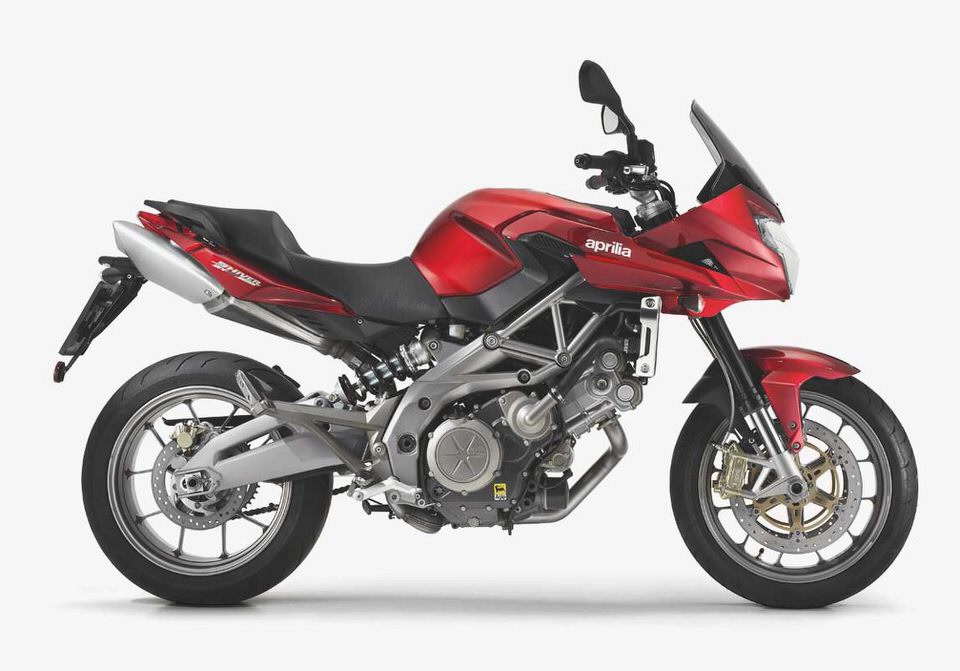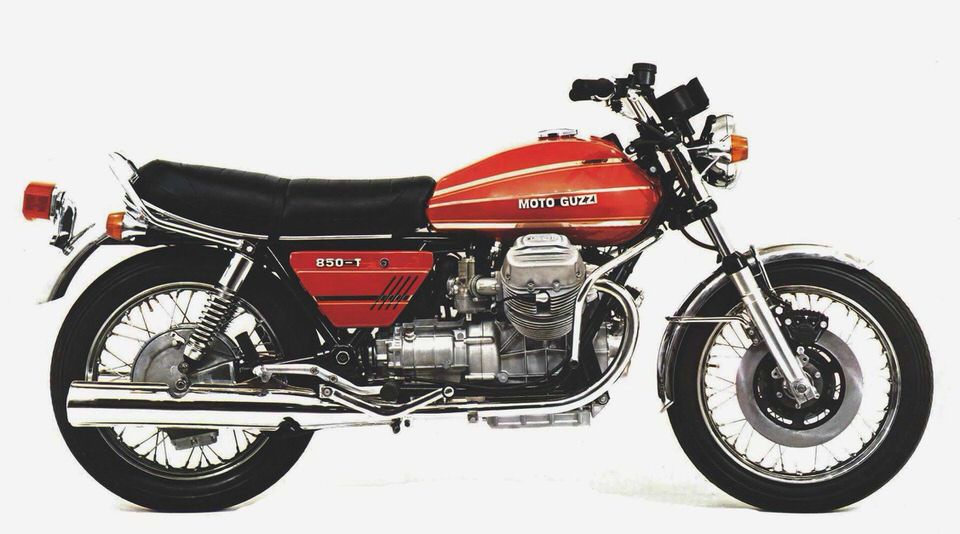What’s New
It’s no coincidence that Moto Guzzi’s Stelvio, introduced in 2008, is named after the fearsome Stelvio Pass in the Alps (and it is fearsome, believe me on this one) – after all, the factory’s not far from there, and the road was used during development of Guzzi’s entry into the big-bore adventure-touring class.
The bike shares the latest version of Guzzi’s classic across-the-frame 90-degree four-valve per cylinder V-twin with the other 1,100 cc members of the family, including the Griso, Breva, and Norge. The 1,151 cc engine is air-cooled but uses an oil cooler, making a claimed 105 hp and 83 ft-lb of torque.
This is the third version of the Stelvio in its short history, the second addressing early complaints via engine mods and adding optional adventure-styled gear. The 2012 version adds more useful torque via a revised exhaust system and makes some of the previously optional gear standard. The exhaust changes result in a strong engine that pulls hard, but oddly still seems a little rev-happy for a big twin.
The Stelvio has air/oil cooling and four valves per cylinder in the 1151 cc V-twin motor.
Other changes for the NTX version include plastic hand guards, a metal guard for the oil sump, driving lights, a larger fairing, a much larger gas tank (32 litres), a larger windscreen and standard aluminum adventure-style side cases (at press time, we didn’t know if removable liners were available, but they are for SW Motech kit and we’ll bet they’d fit).
The Stelvio has a single-sided swingarm and a CARC shaft drive, which is supposed to help eliminate suspension shifting due to throttle use.
The bike also shares its CARC system – Cardano Reattivo Compatto . which translates more or less to Compact Reactive Shaft Drive – with other members of the family. Like BMW’s Paralever system, CARC uses floating torque arms to pretty much eliminate the shaft drive having any effect on suspension due to throttle changes. Of course, de rigeur in the class, it’s a single-sided swingarm system.
It’s tall, and while our taller rider, the inestimable Bondo, could sit on anything and get his big feet flat on the ground, even Larry, with a mere 30-inch inseam, didn’t have much trouble with the seat height in its lower position. A little caution at low speed pays off with lots of leg room which makes a big difference to comfort over a long day.
The Ride
Ah, the Italians.
Where most companies have teams of sober engineers rethinking and redesigning every last detail, it seems the Italians get a few guys together with pencils and paper over a few glasses of Valpolicella and some crusty bread, and at the end of the evening, they declare, “ ‘Atsa good. Party time.”
Tall gearing makes the Stelvio a great bike for long days at high speed. Photo: Moto Guzzi
The riding position is extremely comfortable, the manually adjustable windscreen can be tailored to almost any physique (although not while you’re riding), the standard bags hold lots of “stuff,” and the tall gearing (100km/h at just under 3,500 rpm), 32 liter tank, and 53 miles per gallon (18.76 km/L or 5.33 L/100 km, choose your measurement) make for an excellent all-day cruising mount.
Bondo wondered if the problems he found with low-speed handling were caused by tweaked forks on the test bike. Photo: Moto Guzzi
Handling is great at speed but something made Bondo uncomfortable on the Stelvio at a walking pace. He wondered if the forks had been tweaked at some point (our press unit had 8,000 hard media kilometres when picked up) or the engine’s power pulses were upsetting the chassis but it just felt a bit “odd” at slow speeds. Larry didn’t notice it, possibly worrying more about the height of the bike at low speeds, as he’s six inches shorter than Bondo.
The Brembo brakes were as superb as you’d expect – great feel, good stopping power and wonderful feedback.
The bike ran well over more than 2,000 kilometers during a cool and wet October tour through New England. Throttle response was very good, with a nice linear feel to the throttle response, although there’s not the feeling of a ton of torque off the bottom despite the engine changes intended to promote that, and it didn’t like to be lugged – odd for a motorcycle that has off-road pretensions. Spin it a bit and the 105 horsepower kicked in nicely.
Vibration rears its ugly head at most revs under 5,000 (although Larry thought it added character rather than irritation). Too bad, because cruising at that speed will make your license a distant memory. At legal velocities, objects in the mirror are vague and unidentifiable, although the field of view is at least decent.
The transmission works well; perhaps a tad clunky in first and second – which is hardly uncommon in big-cc twins – but certainly not objectionable. It’s not as crisp or short-throw as a 600 supersport bike, but it’s certainly quite acceptable. Clutch lever effort and engagement were excellent.
The Stelvio has adventurous leanings, but a 272-kg dry weight is going to limit you in the dirt. Photo: Moto Guzzi
Conclusions
Bondo likes the Stelvio’s clocks. However, all the gauges (tripmeter, fuel consumption, etc) reset to zero when you reset one. Photo: Moto Guzzi
The Stelvio has so much potential to be a great adventure tourer, but the Valpolicella boys had better get back to the drawing board, because, although the basic platform is great, the details are somewhat lacking.
Adjustable traction control is nice (and both it and the traction control can be turned off if you’re brave enough to venture far off the pavement), but deciphering how to set it is like translating the Dead Sea Scrolls from the original Hebrew. Ah, the Italians.
The Stelvio comes with a switch for heated grips, and the wiring … and the icon that lights up on the dash showing the three levels of heat you’ve chosen. But, while spotlights are standard on the NTX package, the heated grips themselves are an optional extra. Ask potential owners what they’d rather have standard – superfluous lights or warm hands.
Ah, the Italians.
The instrument package is great, the speedo and tach are easy to read and there’s lots of supplementary info on fuel consumption, average and top speeds, etc. But when you reset any of these functions (like average fuel consumption), everything else also goes back to zero. Ah, the Italians.
The bags don’t lock to the bike, and there are no carrying handles. Photo: Moto Guzzi
Waterproof, top-loading hard bags are standard and hold an acceptable amount of stuff but, even though they’re easily detachable, there are no handles. So you can’t just pop the bags off and take everything into your motel, but must unpack each bag and schlep everything in. Or tuck the bags under your arms, getting road scum over your clothing.
Ah, the Italians.
A two-year warranty is nice; sticker price is around $16,000.
Plus, the bags don’t lock on the bike, so light-fingered Louie can help himself to your bags while it’s parked overnight. The lids don’t lock either, although it appears that there are provisions for locks to be fitted. Ah, the Italians.
For 16 grand, the Stelvio is well-priced in the adventure touring ballpark, the two-year warranty with one-year roadside assistance is nice, and with a few issues addressed, it’d be a great bike. As it stands, it’s close. Damn close.
In all fairness to Guzzi, the Norge that I rode extensively last fall had none of the Stelvio’s perceived shortcomings and you wouldn’t have to run very fast to get me to take a Norge on a cross-country jaunt.
I’m pretty much in the ballpark with Bondo’s riding impressions and conclusions. The bike is so close to being an out-of-the-park grand slam, just missing what seem to us like some no-brainer details; the heated grips and the luggage being tops with me.
The Stelvio doesn’t have much torque off the bottom, and doesn’t like to be lugged. Photo: Moto Guzzi
I probably liked the bike more than Bondo did, enjoying the visceral thumping of the engine where he found annoying vibration. Yeah, it vibes up the mirrors, but who cares where you’ve been, right?
For me as for Bondo, the Stelvio is an excellent bike with some easily-cured faults marring its credentials. C’mon guys, set aside the wine at lunch for a couple of weeks and fix it. None of it is that hard, as you’ve already proved with the excellent Norge, and you’d have the proverbial world-beater if you did.
As with Bondo, I’d take a Norge in my garage before a Stelvio, but fix the niggles and I’d change my mind in a heartbeat.


- Adventure Bike Comparison Review- Off-Road Motorcycling
- Moto Guzzi Griso 8V SE MotorWeek
- Corsa Moto Guzzi MGS 01 Motorcycles
- 2009 Moto Guzzi Stelvio Review – Motorcycle USA
- Who is Elisa? Elisa Travels

